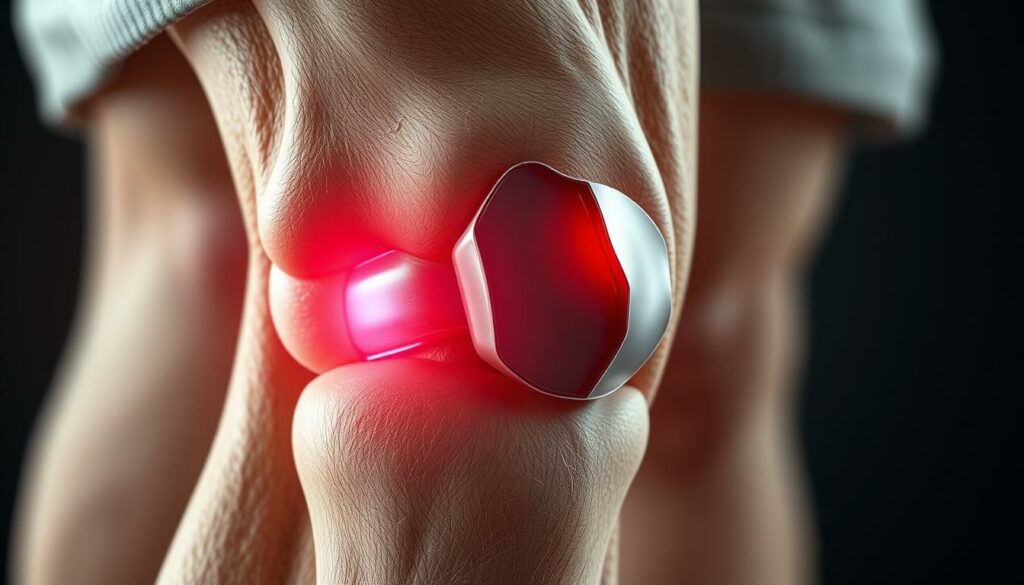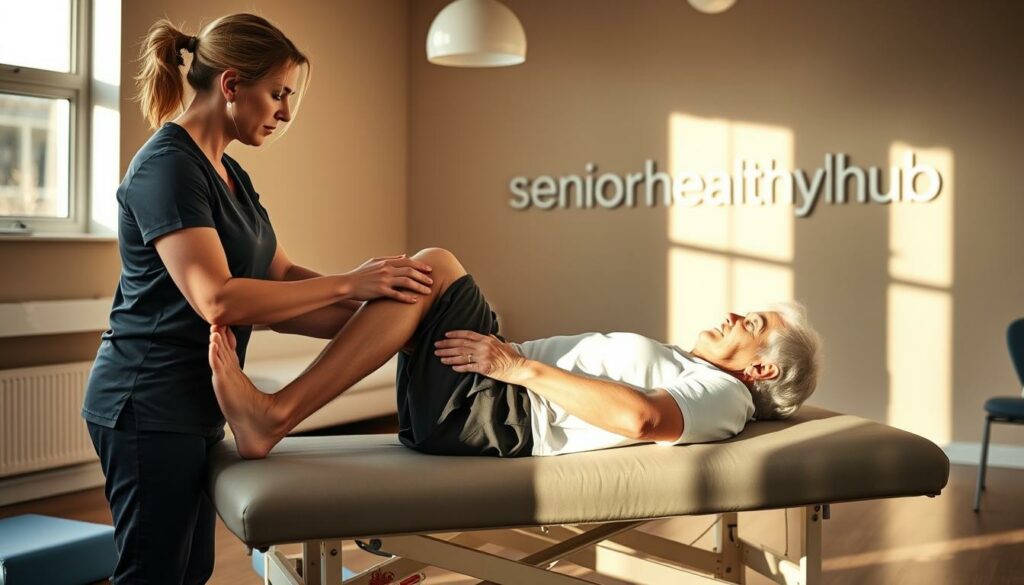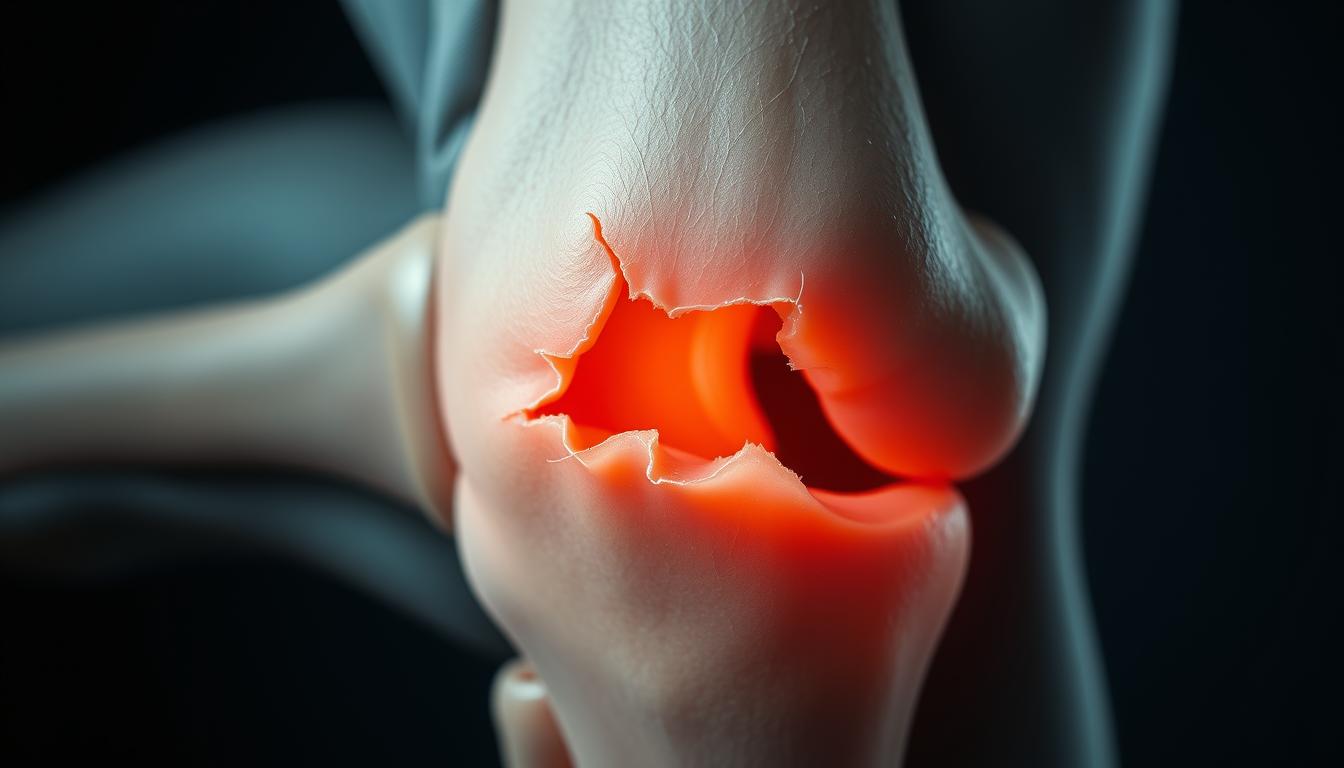As you get older, your knee health becomes more critical. Meniscus tears can cause pain, stiffness, and limit your movement. You might ask, can we prevent meniscus tears, and what’s the best way to treat them?
Meniscus tears are common in older adults. They happen over time due to wear and tear. Studies show that therapy and physical rehab work just as well as surgery for those over 50. Dealing with meniscus tears is key to keeping your knees healthy as you age.
It’s important to know about meniscus tears to keep your knees in good shape. These tears can lead to osteoarthritis, which can also damage the meniscus. So, it’s vital to tackle this issue quickly. With the right treatment, you can manage meniscus tears and keep your knees healthy.
Key Takeaways
- Meniscus tears can occur gradually in older adults due to wear and tear.
- Therapy and physical rehabilitation can yield similar outcomes to surgery for adults over 50.
- Meniscus tears can lead to osteoarthritis of the knee, while osteoarthritis can cause degenerative meniscus tears.
- Understanding the causes, symptoms, and treatment options for meniscus tears is essential for maintaining good knee health in seniors.
- Proper treatment and care can help manage meniscus tears and maintain senior knee health.
- The impact of meniscus tears on senior knee health can be significant, but it can be addressed with the right approach.
Understanding Meniscus Tears in Older Adults
As people get older, the meniscus in their knee joint weakens. This makes it more likely to tear. Tears in the meniscus can hurt knee health and affect joints in seniors. They can cause pain, stiffness, and make it hard to move.
The meniscus helps absorb shock and cushions the knee. But with age, it gets thinner and more likely to tear. Osteoarthritis, affecting 30 million in the U.S., can also harm the meniscus. Even small injuries, like getting up from a chair, can cause tears in older adults.
Some common risk factors for meniscus tears in older adults include:
- Age-related degeneration of the meniscus
- Osteoarthritis
- Reduced blood flow to the meniscus
- Excess body weight, which increases stress on the knees
Knowing why meniscus tears happen is key to preventing and treating them. Older adults can lower their risk by staying healthy and exercising regularly. This helps keep knees healthy and joints strong.
The Impact of Meniscus Tears on Senior Knee Health

As you get older, your knees may face more challenges, like meniscus tears. These tears can cause pain, stiffness, and make it hard to move. If not treated, they can lead to knee osteoarthritis, causing long-term pain and disability.
Treatment for meniscus tears includes physical therapy and pain management. Sometimes, surgery like arthroscopy is needed. It’s important to see a doctor if your symptoms don’t get better or get worse. Early treatment can prevent more damage and improve your health.
Some common signs of a meniscus tear are:
- Pain in the knee joint
- Stiffness and swelling
- Inability to move the knee through its full range of motion
Recovering from a meniscus tear can take weeks to months. It depends on the tear’s severity and the treatment. It’s key to tackle knee health issues early to avoid more problems and keep your knees healthy.
Knowing how meniscus tears affect senior knee health helps you protect your knees. If you notice any symptoms, see a doctor. Follow your treatment plan to manage your knee health challenges.
Recognizing Meniscus Tear Symptoms

As you get older, your knees naturally wear out, raising the chance of meniscus tears. Seniors knee pain is a big problem, and stopping meniscus tears is key to keeping knees moving well. It’s important to know the signs of a meniscus tear early for quick treatment.
A meniscus tear can lead to pain, stiffness, and swelling. You might feel like your knee is catching, popping, or locking. Sometimes, symptoms take time to show up, which is common in older people.
Immediate Signs of Injury
Right away, you might feel sudden pain, swelling, and trouble moving. You might also hear a popping sound when it happens. If you notice these signs, get medical help fast. Early treatment can stop serious damage and improve your recovery.
Long-term Symptoms
Over time, a meniscus tear can cause ongoing pain, less mobility, and less function. If not treated, it can even lead to osteoarthritis. Staying at a healthy weight, exercising regularly, and avoiding too much stress on your knee can help prevent tears and keep your knees moving.
When to Seek Medical Attention
If you have ongoing knee pain or trouble moving, see a doctor. They can spot a meniscus tear with a physical check, your medical history, and tests. Quick treatment can ease your symptoms and stop further damage, helping you keep your knee mobility and avoid knee pain in seniors.
Diagnostic Process for Senior Knee Injuries

When you face effects of knee injuries, getting a detailed check-up is key. This process includes a medical exam and tests like X-rays, MRIs, and CT scans. Meniscal tears are common, affecting 60 people per 100,000. Symptoms can be similar to other knee issues, making a correct diagnosis vital.
A doctor’s physical exam can spot signs of a meniscus tear, like tenderness and swelling. Tests like X-rays and MRIs confirm the diagnosis and rule out other problems. For senior athletic performance, knowing the exact cause is essential for a good treatment plan. Here’s a list of common tests for knee injuries:
| Diagnostic Test | Description |
|---|---|
| X-rays | Use electromagnetic energy to show internal structures |
| MRIs | Use magnets and radiofrequencies for detailed muscle and ligament images |
| CT scans | Give detailed bone, muscle, and organ images, more than X-rays |
Understanding the diagnostic steps for senior knee injuries is the first step to a proper diagnosis. This leads to an effective treatment plan for your effects of knee injuries and better senior athletic performance. If you have ongoing or worsening meniscus tear symptoms, seeing a doctor is critical. It helps avoid long-term damage and improves your health.
Treatment Options for Aging Knees

When looking at treatment for meniscus tears, it’s key to know your options. Meniscus tear rehab often mixes non-surgical and surgical methods. Non-surgical methods like physical therapy and pain management can ease symptoms and boost function. Treatments may also include medicines, corticosteroid shots, and biologic shots.
Knee issues like osteoarthritis can raise the risk of meniscus tears. In these cases, treatments might need to tackle both problems. Your doctor will look at your health and how active you are to pick the best treatment for your tear.
Recovery times for seniors vary based on the treatment. Meniscus tear rehab usually means rest, rehab, and slowly getting back to activities. Your doctor might suggest physical therapy to better your knee’s function and cut down pain. With the right treatment and plan, you can beat knee challenges and move freely again.
| Treatment Option | Description |
|---|---|
| Physical Therapy | A program of exercises and stretches to improve knee function and reduce pain |
| Corticosteroid Injections | Medications injected into the knee to reduce inflammation and relieve pain |
| Biologic Injections | Medications derived from biological sources to promote tissue healing and reduce inflammation |
Daily Living Modifications for Knee Protection
To keep knees healthy in seniors, making daily changes is key. Keeping a healthy weight is important because extra pounds can stress knees more. Regular exercise, like swimming or cycling, helps keep joints and muscles strong.
Small changes in daily life can help a lot. Using canes or walkers can ease knee stress and boost mobility. Adding gentle stretches and strength exercises to your routine can also help. This strengthens muscles around the knee, lowering injury risk.
Some good exercises for knee health include:
- Calf raises
- Hamstring curls
- Leg extensions
- Lunges
- Step-ups
- Squats
These exercises can lessen knee stress and improve mobility in seniors. They help reduce knee injury effects and boost athletic performance.
By adopting these daily changes and doing exercises that support knee health, seniors can lower knee injury risks. This helps keep knees mobile and enhances athletic performance.
Exercise and Physical Therapy Strategies
When dealing with knee health issues, it’s key to think about exercise and physical therapy. These can help improve function and lessen symptoms of a meniscus tear. Meniscus tear prevention is vital, and physical therapy is a big help in this area. Studies show that physical therapy and exercise can make a big difference in managing a meniscus tear, making them great treatment for meniscus tears.
Safe exercises for those with meniscus tears include swimming and cycling. These activities boost heart health without harming the knee too much. Resistance band exercises can also strengthen muscles, while tai chi and yoga improve balance and reduce fall risks.
Physical therapy might include manual therapy, icing, and compression. It might also use neuromuscular electrical stimulation and strengthening exercises. By adding these to your routine, you can actively tackle knee health challenges and aim for meniscus tear prevention.
Long-term Prognosis and Management
Understanding aged knee health is key when dealing with meniscus tears. Almost 1 million people get meniscus tears each year. This number goes up with age, hitting those over 40 hard. Seniors knee pain is common, and meniscus tear symptoms like swelling and pain get worse with weight-bearing activities.
Managing meniscus tear symptoms starts with a healthcare provider’s help. They create a treatment plan just for you. This might include physical therapy to ease pain and improve knee movement. Sometimes, surgery is needed, and its success depends on the tear’s size, location, and your health.
Here are some important points for managing meniscus tears long-term:
- Recovery from meniscus tear surgery takes 4 to 6 weeks to start, and full recovery can take 3 to 6 months.
- Surgery, like arthroscopic, can help by reducing pain and improving knee function.
- Physical therapy can also help by easing pain and improving knee stability.
Knowing how to manage meniscus tears long-term can help prevent more injuries. It’s vital to work with a healthcare provider to create a treatment plan. Making lifestyle changes can also help keep your knees healthy as you age.
Preventing Future Meniscus Injuries
Recovering from a meniscus tear means thinking about meniscus tear prevention to avoid future injuries. This includes keeping a healthy weight and exercising regularly. These steps help reduce stress on your knee joint. This way, you can avoid knee health challenges and recover smoothly.
Using protective gear like knee pads and braces is key for meniscus tear prevention. Also, changing your activities to avoid too much stress on your knee is important. Try low-impact exercises like cycling or swimming instead of high-impact ones like running or jumping.
Working with a healthcare provider to create a treatment for meniscus tears plan is vital. This plan should include lifestyle changes, physical therapy, and other interventions. By being proactive about knee health challenges, you can lower the risk of further injury. This helps you stay healthy and active.
Here are some ways to prevent future meniscus injuries:
- Maintaining a healthy weight to reduce stress on the knee joint
- Engaging in regular exercise to strengthen the muscles around the knee
- Using protective measures, such as knee pads and braces, when engaging in high-impact activities
- Modifying activities to avoid putting excessive stress on the knee joint
Support Systems and Resources for Seniors
Managing senior joint health can be tough. Having a strong support system is key. This includes physical therapy, support groups, and counseling. They help with meniscus tear rehabilitation and knee health challenges.
Studies show that support systems are vital for seniors with meniscus tears. Physical therapy and rehab can improve function and lessen symptoms. Support groups and counseling offer emotional support and guidance.
Here are some examples of support for seniors:
- Physical therapy and rehabilitation programs
- Support groups and counseling services
- Community resources, such as senior centers and transportation services
Using these resources can help you manage knee health challenges better. It can also improve your life quality. Always talk to your healthcare provider before starting any new program.
Conclusion: Living Actively with Knee Health in Mind
When facing meniscus tears and knee health issues, you have the power to take control. Stay proactive, make smart choices, and work with your healthcare team. This way, you can keep living an active and happy life, even as you get older. It’s important to know the meniscus tear symptoms, understand the knee health challenges, and look into treatment options for meniscus tears.
Your knee health is more than just dealing with pain. It’s about keeping your independence, mobility, and enjoying the things you love. By focusing on your knee health, you can keep living an active and vibrant life. This way, injuries or conditions won’t hold you back.
Use the resources and support out there, and work with your healthcare team to create a plan just for you. With the right attitude, care, and changes in your lifestyle, you can beat the challenges. This will let you enjoy your golden years fully.
** Our website contains affiliate links. This means if you click and make a purchase, we may receive a small commission. Don’t worry, there’s no extra cost to you. It’s a simple way you can support our mission to bring you quality content.
FAQ
What is the meniscus and how does it function?
The meniscus is a cartilage piece that cushions the knee joint. It helps absorb shock and distribute weight. This is key for reducing stress on the knee.
What are the common causes of meniscus tears in seniors?
Meniscus tears in older adults can happen for many reasons. These include trauma, aging, and degenerative conditions. As people get older, their meniscus weakens and tears more easily.
What are the risk factors for developing meniscus tears in older adults?
Older adults face a higher risk of meniscus tears due to joint wear and tear. Conditions like osteoarthritis also increase this risk.
How do meniscus tears impact senior knee health?
Meniscus tears can cause pain, stiffness, and limited mobility in seniors. If not treated, they can lead to knee osteoarthritis. This can cause chronic pain and disability.
What are the immediate signs of a meniscus tear?
Signs of a meniscus tear include pain, stiffness, swelling, and a feeling of catching or locking in the knee.
What are the long-term symptoms of a meniscus tear?
Long-term symptoms include chronic pain, limited mobility, and decreased function in the knee joint.
When should seniors seek medical attention for a suspected meniscus tear?
Seniors should seek medical help if symptoms get worse or don’t go away. Early treatment can prevent long-term damage and improve outcomes.
What is the diagnostic process for a meniscus tear in older adults?
Diagnosing a meniscus tear involves a physical exam, imaging tests (like X-rays and MRI), and reviewing medical history.
What are the treatment options for meniscus tears in seniors?
Treatment options include physical therapy, pain management, and surgery (like arthroscopy). The choice depends on the tear’s severity and the person’s health and activity level.
What is the recovery process like for seniors with meniscus tears?
Recovery varies based on treatment. It usually involves rest, rehabilitation, and a gradual return to activity.
How can seniors prevent future meniscus injuries?
To prevent future injuries, seniors should maintain a healthy weight, exercise regularly, and use knee pads and braces. They should also avoid activities that stress the knee too much.
What support systems and resources are available for seniors with meniscus tears?
Seniors can find help through physical therapy, support groups, counseling, and community resources. These include senior centers and transportation services. They help seniors manage their condition and stay independent.


Hi John
Let me appreciate the effort you have put into for writhing this detailed explanation on Meniscus Tears Impact Senior Knee Health, I like how detailed the treatment explanation is all details have been accounted for like physical therapy, Corticosteroid Injections and Biologic Injections.
This article has broaden my horizon and will enable me to take care of my grandfather, for a long term treatment until improvement and hopefully full recovery.
Hi Ravin,
Thank you so much for your kind words! I’m really glad to hear that the article provided valuable insights and that it will help you support your grandfather on his journey to recovery.
It’s great that you’re looking into long-term care options—consistent management can make a big difference in knee health and overall mobility. Wishing your grandfather a smooth recovery and better knee health! Let me know if you have any questions along the way.
Cheers
John